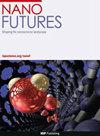Evaluation of in vitro immunostimulatory and cytotoxic effects of recombinant survivin protein in combination with doxorubicin and breast cancer antigen-loaded polycaprolactone nanoparticles
IF 2.5
4区 材料科学
Q3 MATERIALS SCIENCE, MULTIDISCIPLINARY
引用次数: 0
Abstract
In this study, the immunostimulatory and anticancer activities of the doxorubicin (DOX), MCF-7 and MDA-MB-231 breast cancer antigen-loaded polycaprolactone (PCL) nanoparticles (NPs) in combination with survivin recombinant protein (RP) and an alum adjuvant are evaluated in vitro on J774 macrophage, MCF-7 and MDA-MB-231 breast cancer cell lines. A double-emulsion solvent evaporation method was used for encapsulation of DOX and antigens into PCL NPs. The physicochemical characterization of NPs included size, morphology, zeta potential, release profiles and encapsulation efficiencies, analyzed using scanning electron microscopy, a zeta-sizer and UV–vis spectrometry. The cytotoxic and inhibitory effects of NPs were determined using a methyl thiazolyl tetrazolium assay. Immunostimulatory effects of the NPs were detected by Griess reaction and ELISA tests to determine nitric oxide and cytokine levels, respectively. According to the results, DOX and antigen-loaded PCL NPs ranged between 240 nm and 290 nm. Antigen and drug-loaded NPs appear less toxic over macrophage cells in comparison with non-capsulated free agents. In addition, considerable inhibitory effects of antigen and drug-loaded NPs were observed at non-toxic concentrations, such as 25 and 50 μg ml−1, on human mammary cancer cell lines (p⩽ 0.0001). The amount of nitrite released from macrophages that were treated with antigen and DOX-encapsulated PCL NPs, in combination with alum and survivin RP, after 96 h incubation was significantly higher than the control, especially at 50 and 100 μg ml−1, and triggered macrophages to produce high quantities of IL-4 and IL-12 cytokines in contrast to the control. As a result, DOX and antigen-loaded PCL NPs in combination with survivin and alum adjuvant revealed significant immunostimulatory and inhibiting influence on macrophage and breast cancer cells, respectively. The outcomes revealed that antigen and drug-loaded PCL NPs supplemented with survivin RP and an alum adjuvant created an effective platform for the development of nanotechnology-based immunotherapeutic tools to inhibit breast cancer cells. However, these outputs should be supported by further in vivo studies.重组survivin蛋白联合阿霉素和载乳腺癌抗原的聚己内酯纳米颗粒体外免疫刺激和细胞毒作用的评价
在体外实验中,研究了多柔比星(DOX)、MCF-7和MDA-MB-231乳腺癌抗原负载聚己内酯(PCL)纳米颗粒(NPs)联合survivin重组蛋白(RP)和明铝佐剂对J774巨噬细胞、MCF-7和MDA-MB-231乳腺癌细胞株的免疫刺激和抗癌活性。采用双乳液溶剂蒸发法将DOX和抗原包封到PCL NPs中。NPs的理化性质包括大小、形态、zeta电位、释放曲线和包封效率,并通过扫描电镜、zeta-size仪和紫外-可见光谱法进行了分析。采用甲基噻唑四氮唑法测定NPs的细胞毒性和抑制作用。采用Griess反应和ELISA法检测NPs的免疫刺激作用,测定一氧化氮和细胞因子水平。结果显示,DOX和抗原负载的PCL NPs范围在240 ~ 290 nm之间。抗原和载药的NPs对巨噬细胞的毒性比未被包膜的游离物小。此外,抗原和载药NPs在无毒浓度(如25和50 μg ml−1)下对人乳腺癌细胞株有显著的抑制作用(p≤0.0001)。抗原和dox包封的PCL NPs与明铝和survivin RP联合作用于巨噬细胞96 h后,巨噬细胞释放的亚硝酸盐量显著高于对照组,特别是在50和100 μg ml−1时,巨噬细胞产生大量的IL-4和IL-12细胞因子。结果表明,DOX和载抗原PCL NPs联合survivin和明矾佐剂分别对巨噬细胞和乳腺癌细胞有显著的免疫刺激和抑制作用。结果表明,抗原和药物负载的PCL NPs补充了survivin RP和明矾佐剂,为开发基于纳米技术的免疫治疗工具来抑制乳腺癌细胞创造了有效的平台。然而,这些结论应该得到进一步体内研究的支持。
本文章由计算机程序翻译,如有差异,请以英文原文为准。
求助全文
约1分钟内获得全文
求助全文
来源期刊

Nano Futures
Chemistry-General Chemistry
CiteScore
4.30
自引率
0.00%
发文量
35
期刊介绍:
Nano Futures mission is to reflect the diverse and multidisciplinary field of nanoscience and nanotechnology that now brings together researchers from across physics, chemistry, biomedicine, materials science, engineering and industry.
 求助内容:
求助内容: 应助结果提醒方式:
应助结果提醒方式:


